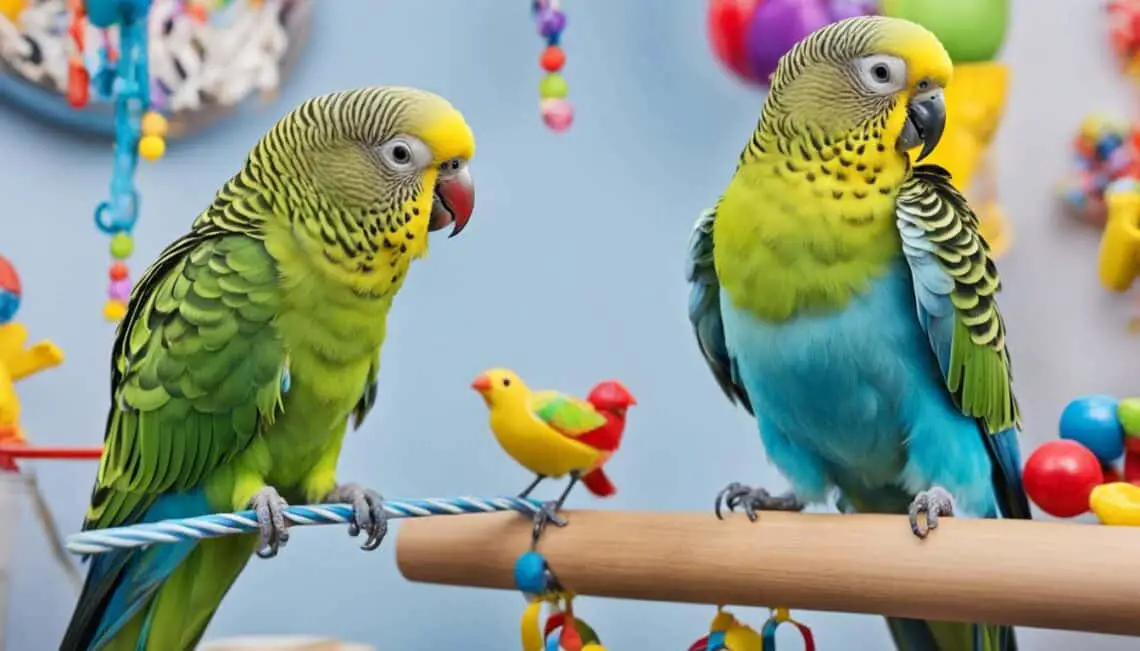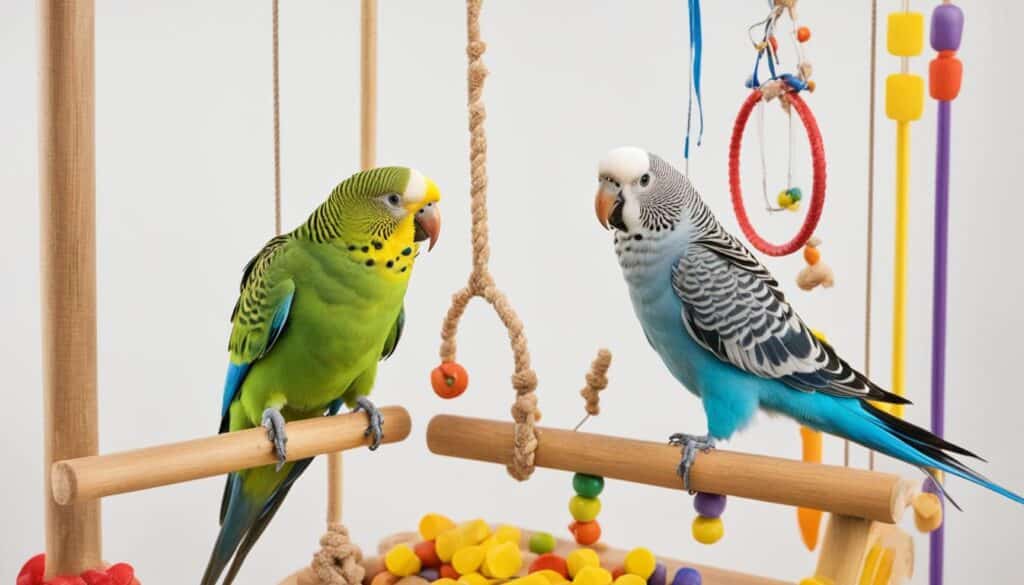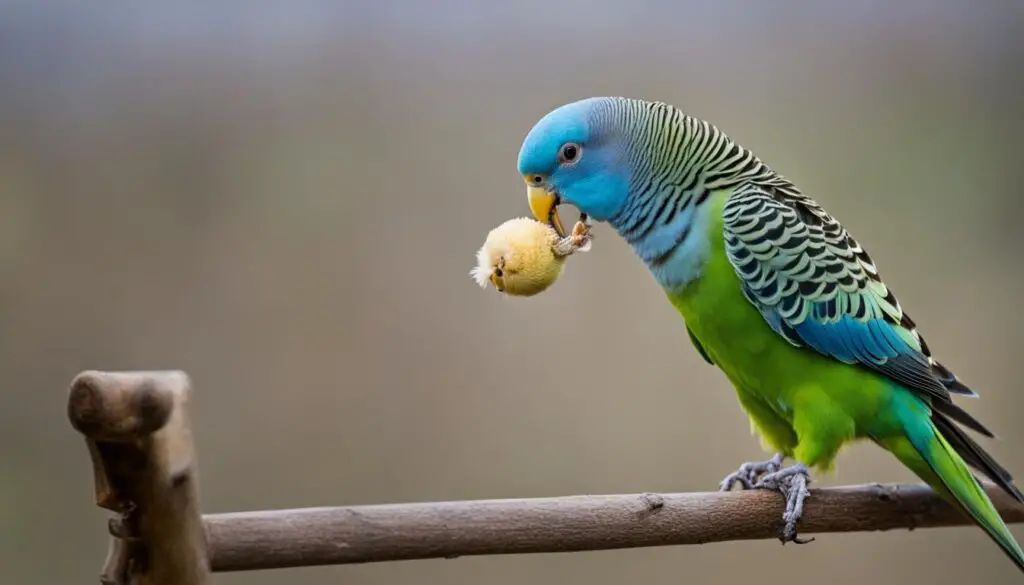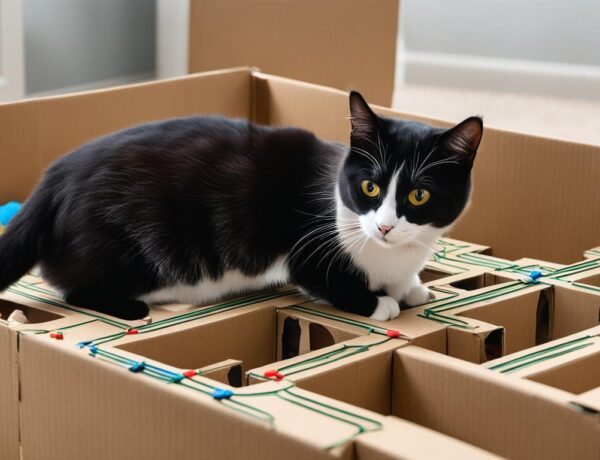If you’re looking to bond with your parakeet and provide mental stimulation for your feathered friend, teaching them tricks is a great way to achieve both. Parakeets are intelligent birds capable of learning a wide range of words and tricks. Not only will training your parakeet to do tricks prevent boredom and encourage physical activity, but it will also nurture a strong bond between you and your pet.
Parakeets are often underestimated when it comes to pet birds, but they have the potential to learn and perform various tricks. Whether you’re a beginner or experienced in parakeet training, there are plenty of fun and easy tricks that you can teach your feathered companion.
Key Takeaways:
- Training your parakeet to do tricks provides mental stimulation, prevents boredom, and encourages physical activity.
- Parakeets are intelligent and capable of learning a wide range of tricks.
- Bonding with your parakeet through trick training strengthens the relationship between you and your pet.
- Start with the “step up” trick as it is an essential skill and a great foundation for other tricks.
- Use positive reinforcement, such as treats and praise, to reward your parakeet for correct behaviors during training.
How to Teach Your Parakeet to Step Up
The “step up” trick is an essential skill to start with when training your parakeet. It allows you to establish trust and build a foundation for teaching more advanced tricks. Teaching your parakeet to step up onto your finger or a perch is a simple yet effective exercise that strengthens your bond.
To train your parakeet to step up:
- Hold your finger or a perch near your parakeet’s belly.
- Say “step up” or a chosen command to signal them to step onto your finger.
- Gently push against their belly to encourage them to step up onto your finger or the perch.
- Reward your parakeet with a treat or praise when they successfully step up.
Repeat this process consistently until your parakeet is comfortable stepping up on command. Be patient and positive during training sessions, as parakeets respond well to gentle guidance and positive reinforcement.
Tips for Effective Finger Training:
Finger training, or teaching your parakeet to step up onto your finger, requires patience and consistency. Here are some tips to ensure successful training sessions:
- Start training in a quiet and distraction-free environment to help your parakeet focus.
- Use a perch or a clean, dry finger without any sharp objects or jewelry that might harm your bird.
- Keep sessions short and frequent, as long training sessions can tire out your parakeet.
- Be consistent with your chosen command, using the same phrase or word every time you want your parakeet to step up.
- Offer enticing rewards, such as small treats or verbal praise, to motivate your parakeet during training.
- Monitor your parakeet’s body language and stop training if they show signs of stress or discomfort.
Remember to enjoy the training process and celebrate your parakeet’s progress. With time and practice, your parakeet will become more confident in stepping up onto your finger or a perch.
| Benefits of the “Step Up” Trick | Training Techniques |
|---|---|
| Strengthens the bond between you and your parakeet | Use positive reinforcement, rewards, and consistent commands |
| Establishes trust and promotes socialization | Train in a quiet and calm environment |
| Provides mental stimulation and physical activity | Keep sessions short and frequent |
| Prevents boredom and encourages social interaction | Monitor your parakeet’s body language and adjust training accordingly |
Fun Tricks to Teach Your Parakeet
Now that you have mastered the “step up” trick, it’s time to move on to teaching your parakeet more fun and entertaining tricks. These tricks will not only provide mental stimulation for your parakeet but also offer you an opportunity to strengthen your bond and have an enjoyable time together. Let’s explore some exciting tricks that you can teach your parakeet:
1. Waving Hello
Teaching your parakeet to wave hello is a delightful trick that can impress your friends and family. To begin, hold a treat above your parakeet’s head and say the command “wave” or any other chosen word. Gently lift your finger from their belly, encouraging them to lift their foot and simulate a wave. Reward them with the treat and praise when they successfully mimic the waving motion. Repeat this process until your parakeet can wave on command.
2. Spinning in a Circle
Watching your parakeet spin in a circle is not only entertaining but also a great way to exercise them. Start by holding a treat in front of your parakeet and say the command “spin” or a chosen word. Slowly move the treat in a circular motion, prompting your parakeet to follow it. Reward them with the treat and praise when they complete a full circle. Practice this trick regularly to reinforce their ability to spin on command.
3. Touching a Target
Teaching your parakeet to touch a target is a fun and interactive trick. Begin by holding a small stick or a pen as a target in front of your parakeet’s beak. Say the command “touch” or a chosen word and wait for your parakeet to touch the target with their beak. Reward them with a treat and praise when they successfully touch the target. Gradually increase the distance and introduce different objects as targets to challenge your parakeet.
4. Playing Dead
The “playing dead” trick is not only amusing but also a great way to showcase your parakeet’s intelligence. Start by gently placing your parakeet on its back in your hand or a soft surface. Say the command “play dead” or a chosen word and wait for them to remain still. Reward them with a treat and praise when they maintain the position for a few seconds. Repeat this process, gradually increasing the duration of playing dead.
5. Retrieving Small Objects
Teaching your parakeet to retrieve small objects is an impressive trick that demonstrates their problem-solving skills. Begin by introducing a small lightweight object, such as a small paper ball or a miniature toy, to your parakeet. Encourage them to pick it up by saying the command “fetch” or a chosen word. Once they grasp the object, offer a treat and praise as a reward. With consistent practice, your parakeet will learn to retrieve various objects on command.
Remember, each trick requires a specific training method and the consistent use of commands and rewards. Be patient with your parakeet and have fun during the training sessions. Your parakeet’s progress may vary, but with regular practice and positive reinforcement, they will learn and amaze you with their tricks.
| Trick | Training Method | Command |
|---|---|---|
| Waving Hello | Hold a treat above your parakeet’s head and lift your finger from their belly | “Wave” |
| Spinning in a Circle | Move a treat in a circular motion, prompting your parakeet to follow | “Spin” |
| Touching a Target | Hold a small stick or pen as a target for your parakeet to touch | “Touch” |
| Playing Dead | Gently place your parakeet on its back and wait for them to remain still | “Play Dead” |
| Retrieving Small Objects | Introduce small lightweight objects for your parakeet to pick up | “Fetch” |
Training Tips for Teaching Parakeet Tricks
When it comes to teaching your parakeet tricks, positive reinforcement is key. By using treats, praise, and attention to reward your parakeet for correct behaviors, you can create a positive learning environment. Avoid punishing your parakeet for making mistakes, as this can discourage them from learning and hinder their progress.
Remember to be patient and take things slow, as parakeets learn at their own pace. Each bird is unique, so it’s important to tailor your training approach to their individual needs. Keep training sessions short but frequent to maintain engagement and avoid overwhelming your parakeet.
Consider using a clicker as a training tool. A clicker is a small handheld device that makes a distinctive sound when pressed. By associating the clicker’s sound with a positive reinforcement, such as a treat, you can more effectively mark desired behaviors and communicate with your parakeet during training sessions.
To make training more enjoyable for your parakeet, incorporate toys, treats, and games into your sessions. This helps to keep their attention and motivation high. Experiment with different types of toys and treats to discover what motivates and delights your parakeet the most.
Consistency is key when teaching parakeet tricks. Practice regularly to reinforce the learned behaviors and maintain their skills. Here are some additional tips to keep in mind:
- Use clear and consistent verbal cues for each trick.
- Break down complex tricks into smaller, manageable steps for easier learning.
- Gradually increase the level of difficulty as your parakeet progresses.
- Train in a quiet and distraction-free environment to enhance focus.
- Monitor your parakeet’s body language to ensure they are comfortable and engaged.
By following these training tips and incorporating positive reinforcement, you can successfully teach your parakeet a variety of tricks, building a stronger bond and creating a delightful experience for both of you.
More Advanced Tricks for Parakeets
Once your parakeet has mastered the basic tricks, it’s time to level up their training with more advanced and complex tricks. These challenging parakeet tricks will not only impress your friends but also provide mental stimulation and physical activity for your feathered friend. Here are some examples of advanced parakeet tricks:
- The Parakeet Stick Trick: Teach your parakeet to balance on a stick or perch, showcasing their agility and balance.
- The Ladder Trick: Train your parakeet to climb up and down a small ladder, demonstrating their climbing skills.
- The Slide Trick: Create a mini slide for your parakeet to slide down, showing off their adventurous side.
- Ball Tricks: Teach your parakeet to interact with different balls, such as playing soccer or pushing a tennis ball around.
- The Tunnel Trick: Construct a small tunnel for your parakeet to navigate through, highlighting their dexterity and problem-solving abilities.
- The Fetch and Drop Trick: Train your parakeet to retrieve small objects and drop them into a designated container, displaying their ability to follow commands and manipulate objects.
- Skateboarding: Yes, your parakeet can even learn to skateboard! With patience and proper guidance, they can master the art of balance and coordination on a mini skateboard.
These advanced parakeet tricks require dedication, time, and patience to teach. Remember, every parakeet learns at their own pace, so be patient with them. Use positive reinforcement, such as treats and praise, to reward your parakeet for their efforts and progress. With consistent training and a supportive environment, your parakeet will surprise you with their complex bird tricks.
Training Tip:
Break down each trick into smaller steps and reward your parakeet for each successful attempt. This approach helps them understand and learn the trick gradually, making it less overwhelming and more achievable.
The Geo Bird Cage for Parakeets
The Geo Bird Cage is a unique and innovative cage design that provides ample space for parakeets to fly in all directions. Unlike traditional cages, which are often shallow front-to-back, the geodesic shape of the Geo Bird Cage allows parakeets to exercise in any direction. It is spacious enough for two birds and has a wire spacing suitable for parakeets, finches, and canaries.
With its revolutionary design, the Geo Bird Cage offers numerous benefits for both parakeets and their owners. The spacious interior ensures that parakeets have room to spread their wings and engage in natural flying behaviors. The geodesic shape also promotes optimal airflow, creating a comfortable environment for your feathered companions.
Designed with both functionality and aesthetics in mind, the Geo Bird Cage features a sleek and modern appearance that complements any home decor. Its transparent construction allows for unobstructed views of your beloved parakeets, fostering a sense of connection and companionship.
In addition to its innovative design, the Geo Bird Cage is equipped with convenient features that make parakeet care effortless. The cage includes removable trays and grates for easy cleaning, as well as multiple access points for feeding and water replenishment.
One of the most noteworthy aspects of the Geo Bird Cage is its versatility. While it is ideal for parakeets, it can also accommodate other small bird species, such as finches and canaries. This makes the Geo Bird Cage a cost-effective option for bird enthusiasts who own multiple species or may consider expanding their flock in the future.
When it comes to providing a comfortable and stimulating environment for your parakeets, the Geo Bird Cage sets the standard. Its innovative design, spacious interior, and modern aesthetics make it a top choice for bird lovers seeking a cage that combines functionality and style.
| Features | Benefits |
|---|---|
| Geodesic shape | Allows parakeets to fly in all directions |
| Spacious interior | Provides ample room for exercise and natural flying behaviors |
| Wire spacing suitable for parakeets, finches, and canaries | Can accommodate multiple bird species |
| Transparent construction | Fosters a sense of connection and companionship |
| Convenient features (removable trays, multiple access points) | Makes cleaning and care effortless |
| Versatile design | Ideal for parakeets, finches, and canaries |
Tricks as Bonding Activities for Parakeets
Teaching your parakeet tricks is not just about entertaining them or showing off their abilities. It’s also an incredible way to strengthen the bond between you and your feathered friend. By engaging in training sessions together and reinforcing positive behaviors, you can build trust and create a deeper connection with your parakeet.
When you train your parakeet, you are fostering a sense of teamwork and cooperation. Your bird learns to trust you and rely on your guidance, which enhances the bond you share. Through consistent training, you establish yourself as a reliable and caring caregiver, which is essential for creating a harmonious relationship with your parakeet.
Tricks serve as bonding activities that allow you to spend quality time with your parakeet. While teaching them new skills, you are providing mental stimulation and physical activity, which are crucial for their overall well-being. These activities also prevent boredom, as parakeets are highly intelligent creatures that need mental challenges to thrive.
As you embark on the training journey, remember to be patient and understanding. Every parakeet learns at their own pace, so it’s important to tailor the training sessions to their individual needs. Use positive reinforcement such as treats, praises, and head scratches to reward your parakeet’s progress and achievements.
Training your parakeet is a fantastic opportunity for you to bond on a deeper level with your feathered companion. Enjoy the process of teaching them tricks and relish in the joy of watching them master new skills. The training sessions will not only strengthen your bond but also create lasting memories that you both can cherish.
Conclusion
Teaching tricks to your parakeet can be a fun and rewarding experience for both you and your bird. With patience, consistency, and positive reinforcement, you can train your parakeet to perform a variety of tricks, from the basic step up to more advanced tricks like ladder climbing, ball tricks, and tunneling.
Remember to keep training sessions short, make them fun, and practice regularly to reinforce the learned behaviors. By using treats, praise, and attention as rewards, you can encourage your parakeet to master new tricks and deepen the bond between you and your feathered friend.
Enjoy the journey of training your parakeet and witnessing their growth and development. Not only will your parakeet benefit from the mental stimulation and physical activity, but you will also create lasting memories and a stronger connection with your pet. So, grab some treats, get ready to have fun, and let the training begin!
FAQ
What are the benefits of training my parakeet to do tricks?
Training your parakeet to do tricks provides mental stimulation, prevents boredom, encourages physical activity, and nurtures a bond between you and your pet.
What is the first trick I should teach my parakeet?
The essential trick to start with is the “step up” trick, which involves teaching your parakeet to step onto your finger or a perch when commanded.
How do I train my parakeet to step up?
To train your parakeet to step up, hold your finger or a perch near their belly, say “step up” or a chosen command, gently push against their belly to encourage them to step up, and reward them with a treat or praise when they successfully step up.
What are some other tricks I can teach my parakeet?
Some fun and entertaining tricks you can teach your parakeet include waving hello, spinning in a circle, touching a target, playing dead, and retrieving small objects.
How should I reward my parakeet during training?
It’s important to use positive reinforcement, such as treats, praise, and attention, to reward your parakeet for correct behaviors during their training sessions.
Can I punish my parakeet for making mistakes during training?
It’s best to avoid punishing your parakeet for making mistakes during training, as this can discourage them from learning. Instead, focus on positive reinforcement and patience.
What are some more advanced tricks I can teach my parakeet?
More advanced tricks for parakeets include the parakeet stick trick, ladder trick, slide trick, ball tricks (soccer, tennis ball), tunnel trick, fetch and drop, and even skateboarding.
What is the Geo Bird Cage and why is it ideal for parakeets?
The Geo Bird Cage is a unique and innovative cage design that provides ample space for parakeets to fly in all directions. Its geodesic shape allows parakeets to exercise in any direction, and it is suitable for housing multiple birds.
How do training tricks strengthen the bond with my parakeet?
Training tricks with your parakeet serves as bonding activities and allows you to spend quality time together, reinforcing positive behaviors and building trust and connection.







No Comments